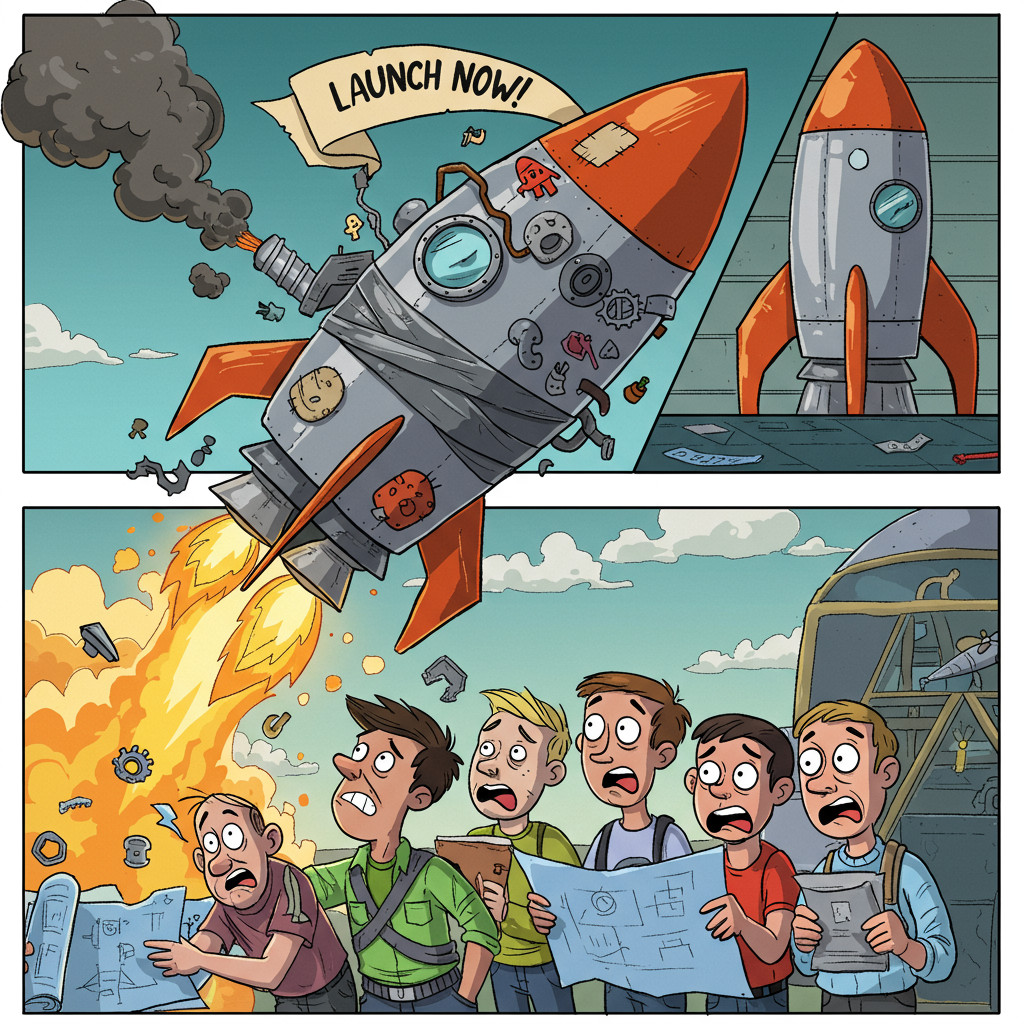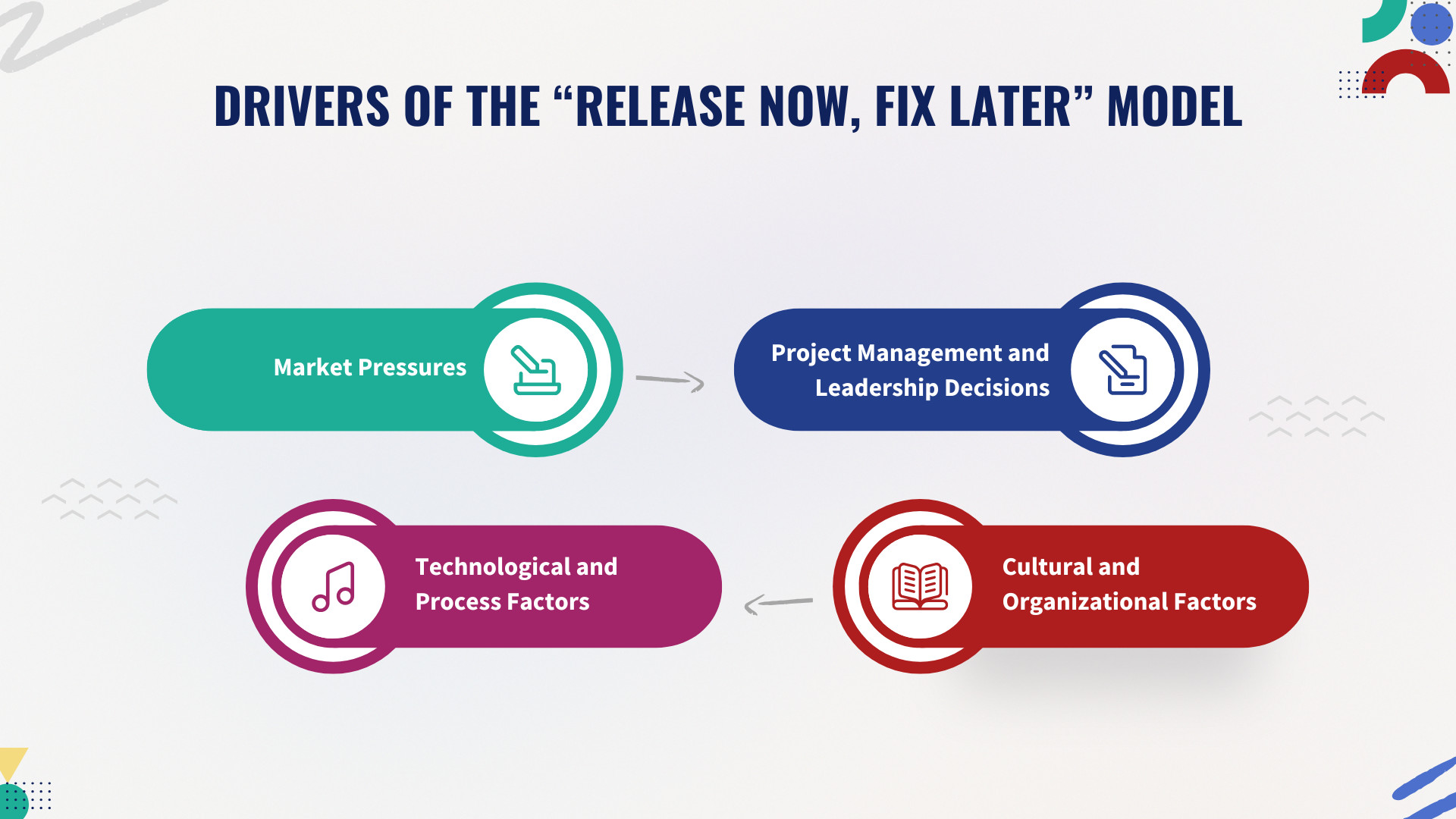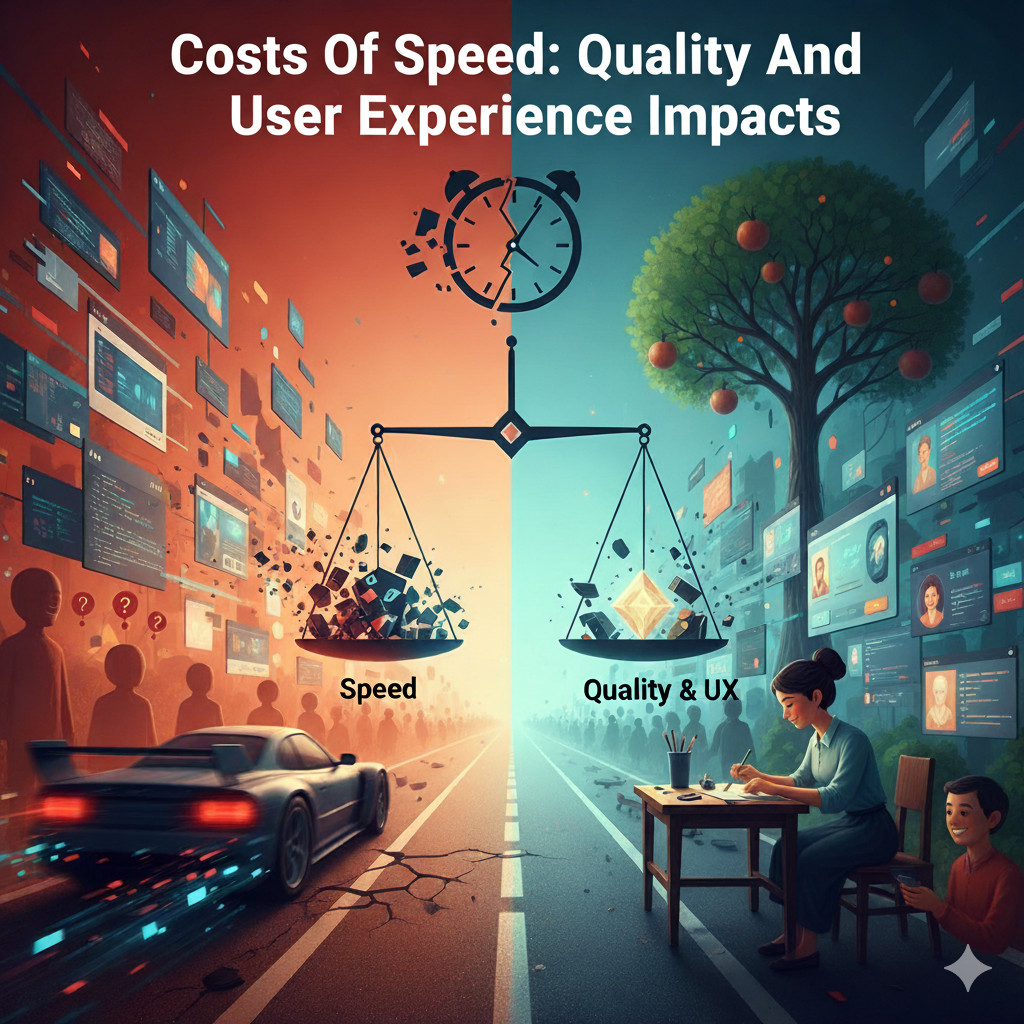Quality vs Speed: The True Cost of “Ship Now, Fix Later”
|
|
Today, we see that the “ship now, fix later” approach is becoming increasingly accepted in software development. It’s an easy-to-understand philosophy: Ship features fast, get the edge over competitors, and worry about fixing problems later. This approach may make sense for startups pressed by investors or companies in a race with competitors. Customers have a sense of constant progression, revenue opportunities come faster, and the team doesn’t get caught up in endless testing cycles.
But beneath this allure lies a hidden cost, sometimes minor inconveniences, other times catastrophic consequences. Speed often comes at the expense of quality, and the fallout can include customer dissatisfaction, loss of trust, spiraling technical debt, and long-term damage to a brand’s reputation.
| Key Takeaways: |
|---|
|

What Does “Ship Now, Fix Later” Mean?
Ship now, fix later is a software development philosophy where developers release a product as soon as it is coded, even though it may be incomplete, unstable, or full of known bugs. The point is to release something quickly to the market, get attention or feedback, and be concerned with correcting issues in subsequent patches or updates. It might appear to be practical at first, as it assists teams in meeting deadlines, attracting early users, and competing in fast-moving industries. However, in the long run, this strategy may have severe effects on the quality of the product and user confidence.
Origins of the Approach
The philosophy of fast release is a result of the need to be the first to market. Patching was a costly and infrequent activity in the early days of software and games, but with the advent of the internet and digital distribution, it became simpler. This gave the perception that it was okay to ship a product early, even in a broken form, since updates could always be provided later. Agile and continuous delivery practices, although intended to encourage incremental improvements, were occasionally misunderstood as permission to release early.
Why is it Prevalent in Software and Game Development
This model succeeds in the industries where speed is survival. In competitive markets, the first is usually better than perfect. In the case of software startups, an early release may be used to attract investors or prove a business idea. In the gaming industry, businesses occasionally release games in time to satisfy the holiday seasons, advertising campaigns, or the release of new consoles. Ship now, fix later has become the norm due to the proliferation of patching tools, hotfix pipelines, and live-service models. It is a pity that even though this strategy may bring short-term victories, it is often accompanied by long-term expenses.
Drivers of the “Release Now, Fix Later” Model
Prioritizing speed over quality is not often an accident. It typically results from several pressures, market forces, leadership decisions, technical limitations, and corporate culture. Knowing these drivers makes sense of why the model pervades everywhere despite its known risks.

Market Pressures
Time-to-market in competitive industries can be a success or a failure. First mover companies have an opportunity to get users, media coverage, and investment ahead of other competitors. This has pushed the teams into corners when it comes to testing, polishing, and optimization.
- Startups can release a minimum viable product (MVP) to simply demonstrate that an idea is viable. Read: Mastering MVP Testing.
- Stability is not always rewarded by investors and other stakeholders; early traction is.
Project Management and Leadership Decisions
Leadership is also important in imposing deadlines, despite the knowledge that the product is not ready. Project managers, who are under pressure by executives or investors, can insist on release dates that are more focused on visibility than stability.
- The deadlines are associated with financial quarters, marketing campaigns, or investor reports.
- Leaders can believe that problems can always be fixed once the software is launched.
- Teams are motivated to achieve milestones, rather than produce refined quality.
Technological and Process Factors
The subsequent patching becomes less difficult with the current development practices and tools, which also encourages hasty releases.
- Continuous integration and delivery (CI/CD) pipelines make rapid updates possible.
- Hotfixes and patches can be implemented within hours with cloud infrastructure. Read: How to Test a Hotfix?
- Automated testing may also be a fallacy of deception that conceals the actual issues in such scenarios.
Cultural and Organizational Factors
The fix later becoming the norm is heavily influenced by the culture of an organization. Some companies are much more glorified in speed and feature delivery than in stability and craftsmanship.
- Teams are rewarded for producing fast products, but the product may be buggy.
- Quality assurance is not considered solemnly, and it is treated as a bottleneck rather than a safeguard.
Costs Of Speed: Quality And User Experience Impacts
Hurrying to launch without careful consideration of quality is likely to give temporary benefits at the cost of long-term costs. These not only affect the software but also the users, the reputation of the company, and the development team.

Software Stability and Bugs
With regards to speed, the testing and polish are affected, which leads to unstable software. Bugs which should have been spotted earlier creep into the production process where they are far more expensive and difficult to fix.
- Users are annoyed by frequent crashes, glitches, and broken features.
- Hotfixes are a waste of development time.
- Products gain a reputation for being unreliable, and it becomes difficult to retain them.
User Trust and Reputation
Customers make snap decisions on the quality of products. A bugged release is an indicator of laxity, and this may forever destroy trust. Reputation is very hard to regain once it is lost.
- Early adopters can drop the product and post negative reviews.
- The damage to reputation spreads to subsequent products of the same company.
- Competitors benefit when users switch to substitutes.
Support and Maintenance Overheads
Hasty releases add to the workload of customer support and maintenance. They are not working on what can be done to improve in the future, but rather dealing with the consequences of the current problems.
- Support teams are exposed to increased ticket volumes, escalations, and refund requests.
- Bug fixes are taking developers off the innovation path.
- There is an increase in operational costs because of the continuous firefighting.
Hidden Costs Beyond Code

Although the most obvious costs of rushing software releases are manifested in bugs and user frustration, there are other less obvious costs. These unseen effects are spread to security, operations, innovation and even investor relations.
Security Vulnerabilities
Security testing and reviews are usually omitted or reduced to a minimum when software is in a hurry. This creates vulnerabilities in the system that can be exploited by attackers.
- The way rushed releases introduce exploitable vulnerabilities: Lacking validations, unpatched dependencies, and untested integrations are the points of cyberattacks. Read: Cybersecurity Testing and Impact of AI.
- Security debt costs over the long-term: Security vulnerabilities found after release are costly to fix and may lead to data breaches, regulatory fines, and loss of customer trust in the long-term.
Customer Support and Operational Burden
A defective product adds to the burden of the support teams that have to address the impact of low quality. There is also an increase in complexity in the maintenance of unstable systems by the operations staff.
- Increasing helpdesk, refunds, and escalations: Every unresolved problem creates financial expenses and human resource consumption.
- Higher churn and retention loss: Frustrated users can switch permanently, increasing the cost of replacing them.
Innovation Debt
Each bug that makes it to production leaves behind an innovation debt, time and energy wasted on the past rather than the future.
- Fixing time is an opportunity cost to innovating: Developers are in rework loops rather than feature development.
- Opportunity cost of reactive engineering: Firms lose their competitive advantage as energy is diverted to strategic enhancement to reactive maintenance.
Reputation and Investor Confidence
In addition to the users, rushed releases hurt the perception of the company by partners, stakeholders, and investors. Trust and confidence are delicate properties that can be destroyed easily.
- The impact of repeated broken launches on valuation: Investors will be cautious about supporting a company that has a history of unstable products.
- Unnoticed harm in partnerships and collaborations: Partners might be reluctant to assimilate or depend on systems with a history of instability, which limits growth prospects.
Long-Term Consequences Of The Model
Ship now, fix later can give short term wins like release faster or capture the market earlier but the long-term consequences of it are devastating and difficult to reverse. These spill out in the financial performance area, brand perception area, exposure to legal environment, and organizational culture.
Financial Fallout
Speeding up releases can be expensive and the short-term gains might not be as high as the initial gains. It is significantly more expensive to rectify manufacturing mistakes than it is to rectify design mistakes. This creates more and more financial pressure.
- Hotfixes and reworks are emergency and bloat development budgets.
- The customer churn rate is high, forcing increased marketing and user acquisition spending.
- As users switch to more stable alternatives, they lose revenue opportunities.
Erosion of Brand Equity
The reputation of a brand is based on trust, reliability and user satisfaction. The constant delivery of buggy or incomplete products undermines this base.
- Customers start relating the brand to instability and frustration.
- Word of mouth and reviews increase negative sentiment.
- The competitors who have better reputations are able to capture the market share easily.
Cultural Decay
The worst impact is perhaps in the organization itself. An organization that values speed over quality erodes the morale of the team and professional pride.
- When developers are constantly told to patch later, rather than build well, they lose motivation.
- The exhaustion increases due to the continuous firefighting and crisis management.
- In the long run, high turnover and loss of skills undermine the capacity of the organization to provide sustainably.
The Vanguard: When “Fix Later” Works (Momentarily)
Despite the fact that the ‘ship now, fix later’ model is risky, there are some controlled situations in which it may work – at least in the short run. The strategy in such situations is not neglecting quality but rather utilizing the real-life feedback to inform the improvements.
Soft Launches and Beta Testing
A beta release or soft launch is a deliberate attempt to release an incomplete product to a small group of users. It is not about speed but learning by the users in a controlled setting.
- Developers are able to receive real-life feedback prior to a worldwide launch.
- Problems can be resolved in a cyclic manner without hurting the brand on a large scale.
- Early adopters are also known to tolerate flaws in an attempt to gain early access.
Live Service Products and Games-as-a-Service
In the case of live-service products, the continuous update model is embedded in the business. Players anticipate constant patches, new content, and balancing changes.
- Small bugs during the initial release can be accepted, provided that the fixes and updates are fast.
- Developers are able to focus on fast delivery of features and improve stability over time.
- Close interaction with the community is essential to ensure trust.
Continuous Delivery in Mature Teams
The fact that organizations with good DevOps pipelines and testing practices release their products rapidly does not mean that they compromise quality. Mature teams can roll out on a regular basis and also be able to respond to the issues in a short time.
- There are automated tests and monitoring that identify problems at an early stage and that can have minimal effects on the user.
- Feature flags allow teams to instantly roll back or disable unstable features.
- Continuous integration implies that the fixes are offered almost as soon as the issues are detected.
Organizational Shifts for Sustainable Quality
Sustainable quality is not a technical issue only; it is a commitment of the organization. Cultural, process, and communication changes that transform quality into a common concern at all levels are necessary to ensure that companies stop thinking ship now, fix later.
Leadership Culture Redesign
Leadership starts with quality. When executives and managers only focus on speed and delivery deadlines, teams will automatically cut corners. Leaders should be the first to lead by example by appreciating quality over speed.
- Re-consider the metrics of success to add reliability, customer satisfaction, and the maintainability of success in the long-term.
- Not just reward the teams based on fast feature delivery, but also based on bug prevention.
Best Practices in Development Pipeline
Speed and quality are not opposites but they co-exist and are mighty forces. Automation, testing and monitoring should be the main development pipeline of modern development.
- Use CI/CD and try to get the best test coverage.
- Mechanize security, high performance, and regression tests to avoid the unexpected at the last minute.
- Have quality gates in the pipeline where the unstable builds are not allowed to be released.
Transparent Communication with Stakeholders
The stakeholders, customers, investors, and the partners should be aware of the quality commitment of the company. With transparency, there can be confidence, even in the case of failure.
- Make natural expectations regarding release dates or features.
- Provide the policies of after-launch support to reassure the users.
- When quality demands, be open to delays.
The stakeholders will also adopt sustainable practices more easily than rushing into sustainable practices without thinking about it, and being honest and accountable.
Conclusion
“Ship now, fix later” is tempting in a world obsessed with speed and disruption. In certain contexts, like MVPs or experimental features, it may even be appropriate. However, as organizations grow, the costs outweigh the benefits. Customer trust, brand reputation, and long-term sustainability hinge on balancing speed with quality.
The most successful companies understand that speed and quality are not mutually exclusive. By investing in testing, aligning incentives, and building cultures of accountability, organizations can ship fast without leaving chaos in their wake.
In the end, shipping quickly may win the sprint, but prioritizing quality ensures victory in the marathon.
| Achieve More Than 90% Test Automation | |
| Step by Step Walkthroughs and Help | |
| 14 Day Free Trial, Cancel Anytime |












